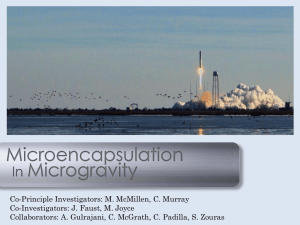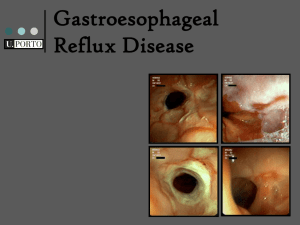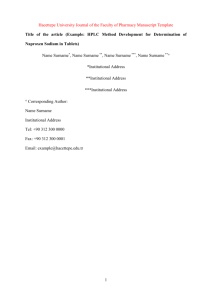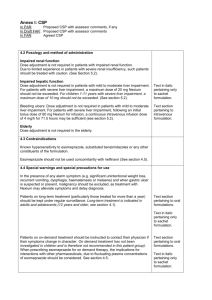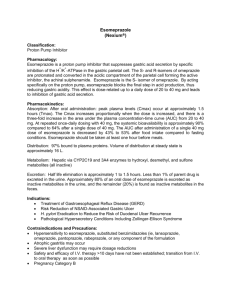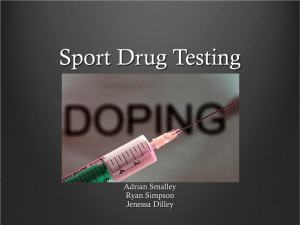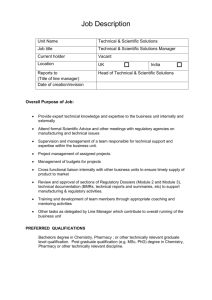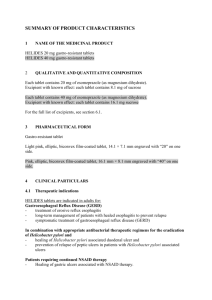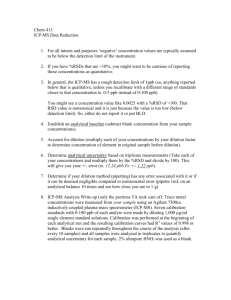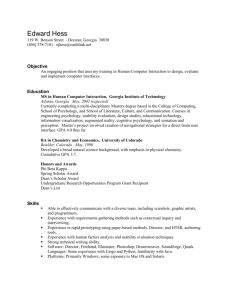development and validation of method for determination of
advertisement
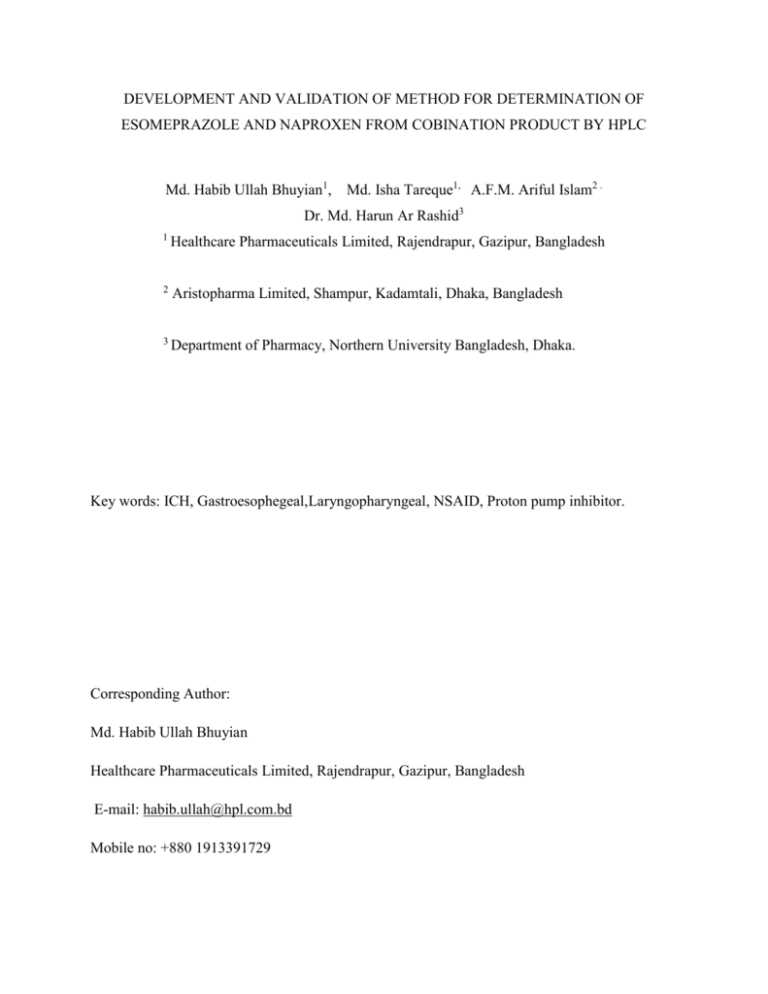
DEVELOPMENT AND VALIDATION OF METHOD FOR DETERMINATION OF ESOMEPRAZOLE AND NAPROXEN FROM COBINATION PRODUCT BY HPLC Md. Habib Ullah Bhuyian1, Md. Isha Tareque1, A.F.M. Ariful Islam2 . Dr. Md. Harun Ar Rashid3 1 Healthcare Pharmaceuticals Limited, Rajendrapur, Gazipur, Bangladesh 2 Aristopharma Limited, Shampur, Kadamtali, Dhaka, Bangladesh 3 Department of Pharmacy, Northern University Bangladesh, Dhaka. Key words: ICH, Gastroesophegeal,Laryngopharyngeal, NSAID, Proton pump inhibitor. Corresponding Author: Md. Habib Ullah Bhuyian Healthcare Pharmaceuticals Limited, Rajendrapur, Gazipur, Bangladesh E-mail: habib.ullah@hpl.com.bd Mobile no: +880 1913391729 INTRODUCTION The Naproxen is a Non-steroidal anti-inflammatory drug (NSAID) having chemical name (+)(S)-6-Methoxy- -methyl-2-naphthaleneacetic acid. The empirical formula is C14H14O3 and its molecular weight 230.26 [1] . Naproxen is white to off white practically odorless crystalline powder. Soluble in chloroform, in dehydrated alcohol, sparingly soluble in ether, practically insoluble in water [2] . Naproxen is used to inhibit prostaglandin synthesis as a result it acts as analgesic, anti-inflammatory and anti-pyretic properties [3]. The Esomeprazole is a proton pump inhibitor having chemical name 1 H-Benzimidazole, 5methoxy -2 [(s)-[4-methoxy -3,5-dimethyl -2-pyridenyl)methyl] sulfinyl], magnesium salt trihydrate. The empirical formula is C34H36MgN6O6S2.3H2O and its molecular weight is 767.17.[4] Esomeprazole is white to slightly colored powder, soluble in methanol, slightly soluble in water, practically insoluble in heptanes [5] . Esomeprazole is used to treat dyspepsia, peptic ulcer disease, gastroesophageal reflux disease, laryngopharyngeal reflux, and Zollinger–Ellison syndrome and NSAID associated ulcer. Validation is a fast growing and evolving subject. It is a requirement that has always made sense from both a regulatory and quality perspective. [6], [7]. The analytical process are generally validated following the general non-mandatory guidelines as this process varies so widely and there is no universal approach from regulatory bodies such as US FDA and EC.[8],[9]. The most common reason for validation is to guarantee as per as possible that all process and machinery in the pharmaceutical manufacturing process are being used in a way which will ensure safety, integrity, quality and strength of the product for use by general public.[10], [11]. Densitometric determination of Esomeprazole with Domperidone was also established [12]. Spectroscopic estimation of Esomeprazole magnesium in solid dosage form with some other NSAID’S [13-16] Physico-chemical characterization, UV Spectrophotometric method development and validation studies for Esomeprazole Magnesium Trihydrate was reported in Literature [17-18]. A UPLC stability indicating method for determination of impurities in Esomeprazole Magnesium gastro resistant tablets was also reported in the literature [19]. Only few methods are available for determination of Naproxen and Esomeprazole in the product. So present work was undertaken with the aim to develop and validate a rapid and consistent reversed phase high performance liquid chromatographic method for determination of Naproxen and Esomeprazole according to ICH guideline. [20]. MATERIALS AND METHODS [21-22] Reagents and chemicals HPLC grade Acetonitrile, HPLC grade Methanol & Triethylamine, Glacial acetic acid, Disodium Hydrogen Phosphate, Potassium Dihydrogen Phosphate and Sodium Hydroxide, from Merck Germany. Naproxen WS, from Dr. Reddy’s Laboratories Ltd, Mexico. Esomeprazole Magnesium WS from Cameo Healthcare, India and Millipore water. Instruments Analytical balance Sartorious (model: TE214S). HPLC Dionex Ultimate 3000, HPLC Shimadzu Prominence, Hanna pH meter, Column (Cogent, C18, 250mm x 4.6mm, 5µ). Method Development [23-28] Preparation of mobile phase A mixture of Buffer, Acetonitrile and methanol in the ratio of 50:40:10 was added with 0.1% v/v Triethylamine and finally adjusted with glacial acetic acid to a pH of 7.0. Preparation of Buffer Solution was prepared by adding dibasic sodium phosphate (1.42 mg/ml) and monobasic potassium phosphate (1.36 mg/ml) in HPLC grade water. Preparation of Diluents A mixture of 0.1M Sodium Hydroxide and Methanol was prepared in the ratio of 50: 50. Chromatographic Condition Cogent C18, 250 mm x 4.6 mm, 5 , Injection volume 20µl, wavelength 303 nm, temperature 30⁰C± 2⁰C, Flow rate 1.0 ml/min. Standard preparation Naproxen stock solution At first, about 38.0 mg of Naproxen WS was transferred into 25 ml volumetric flask then added about 20 ml of diluting solvent and sonicated sufficiently to completely dissolve the content. The solution was kept for few minutes to cool the content at room temperature and made volume up to the mark with diluting solvent. Esomeprazole Stock solution About 22.3 mg of Esomeprazole Magnesium WS was transferred into 100 ml volumetric flask then added about 70 ml of diluting solvent and sonicated sufficiently to completely dissolve the content. The solution was kept for few minutes to cool the content at room temperature and made volume up to the mark with diluting solvent. Final standard solution: Transferred 5 ml stock solution from Naproxen and 2 ml stock solution from Esomeprazole magnesium into 50 ml volumetric flask and made the volume up to the mark with mobile phase. Sample preparation: An average weight of randomly selected 20 tablets was determined and crushed to fine powder with mortar and pestle. Accurate weight of powder that contains about 500 mg Naproxen and 20 mg Esomeprazole was transferred into 200 ml volumetric flask. Then about 150 ml of diluting solvent was added and Sonicated about 60 minutes with intermittent shaking. The sample was kept for few minutes to cool at room temperature and made volume up to the mark with diluents. The solution was filtered through Whatman filter paper No 42 and collected the filtrate discarding first few ml. 3 ml of filtrate was diluted to 50 ml with mobile phase. Then the solution was filtered through 0.45 µ disk filter and collected the filtrate. System suitability solution The final standard solution was used as system suitability solution. 20 µl of five replicate injections of standard solution were injected. The chromatogram was recorded and the system suitability parameters of the injections were checked for % RSD of area within 2.0 %. The resolution and the plate count should not be less than 1.5 and 2000 respectively. However, the tailing factor should not be more than 2.0. Method Validation [23-28] System suitability The system was deemed suitable if the following acceptance criteria were satisfied. The relative standard deviation (% RSD) of the peak area responses for Naproxen and Esomeprazole from five replicate injections of standard solution was not more than 2.0%. The resolution and the plate count should not be less than 1.5 and 2000 respectively. However, the tailing factor should not be more than 2.0. Specificity For specificity study identification, placebo interference and RT ratio of sample and standard were observed. Linearity The linearity was carried out by observing the correlation coefficient (r) of standard solution. System Precision System precision was carried out by performing six replicate injections of standard at 100% of the test concentration and calculating the % RSD of the measured area. Method precision To demonstrate method precision, six replicate of sample against standard at 100% of test concentration was carried out and the precision of method was calculated by computing % RSD of six measurements. Intermediate precision (Ruggedness) Intermediate precision or ruggedness study of an analytical method is the degree of reproducibility of the test results obtain by the analysis of the same samples under a variety of normal test conditions. Test sample of Naproxen and Esomeprazole representing single batch was analyzed by two different analysts in two different equipments at different days. The ruggedness of the test method was calculated by measuring % RSD of six results and % RSD of results of two analysts. Accuracy Study was carried out over a range of 80% - 120% (3 replicate each) of the test concentration. The % recovery and RSD of % recovery for each concentration was also measured. Range Data generated in linearity, precision and accuracy were considered for establishing the range of the analytical method. Robustness Robustness of the method was investigated by changing flow rate (±0.1%), column temperature (±5⁰C) and ratio of components of mobile phase. Stability study The solution stability experiments were carried out under room temperature at intervals of 0h, 6h, 12h, 18 h, 24 h, 30h, and, 48 h. RESULTS AND DISCUSSION System suitability System suitability is an integral part of analytical procedures. The result obtained from the System suitability is shown in table 01&02. In optimized chromatographic conditions, Relative Standard Deviation (% RSD) of area and retention time of Naproxen and Esomeprazole were 0.07%, 0.116% and 0.049% and 0.034%, respectively. The average tailing factor for Naproxen and Esomeprazole were 1.036 and 0.92, respectively at average resolution 8.078. The obtained results satisfy the USP requirements. Specificity Specificity of an analytical method is its ability to assess unequivocally the analyte in the presence of components that may be expected to be present. Lack of specificity of an individual analytical procedure may be compensated by other supporting analytical procedures.[29] From the specificity study it was observed that the chromatogram for naproxen and Esomeprazole sample with reference standard showed positive response and Blank (Placebo) had no response, So the method was specific. System precision System precision was carried out by performing six replicate injections at 100% of the test concentration and calculating the %RSD, Tailing factor, resolution and Theoretical plate count. From the data (Table 01 & 02), it is observed that Relative Standard Deviation (% RSD) of area and retention time of Naproxen and Esomeprazole were 0.07%, 0.12% and 0.049%, 0.034%, respectively. The average tailing factor for Naproxen and Esomeprazole were 1.036 and 0.92, respectively at average resolution 8.078, whereas, theoretical plate count for Naproxen and Esomeprazole were 5407 and 6008 respectively. The results correspond the USP requirements. Method precision The result shows that the % RSD of six samples was found to be 0.78% and 0.074% for Naproxen and Esomeprazole (table 03) . Intermediate precision or Ruggedness Assay result by two different analysts at different days have been found quite close to each other and % RSD of two analysts (12 samples) is 1.244% for Naproxen and 0.28% for Esomeprazole which was within acceptance criteria. So the method can be considered to be rugged enough (Table-03 ) Accuracy The accuracy of an analytical method is the closeness of test results obtained by that method to the true value. The result shows that average % recovery at different accuracy levels are 99.98% and 99.70% for Naproxen and Esomeprazole respectively (Table-04). Correlation coefficient for Naproxen and Esomeprazole is 1.0000 (Figure 03 & 04). Linearity The linearity of an analytical method is its ability to elicit test results directly proportional to the concentration of the analyte in samples within given range. [30] . Linearity of the method was evaluated from the correlation coefficient of calibration curves that were constructed from mean peak area of Naproxen and Esomeprazole at different concentrations level of 80%, 90%, 100%, 110% and 120% (Table 05). Correlation coefficient for Naproxen and Esomeprazole were 0.9998 and 0.9997, respectively (Figure 03 & 04). Range The specified range is normally derived from linearity studies and depends on the intended application of the procedure. It is established by confirming that the analytical procedure provides an acceptable degree of linearity, accuracy and precision when applied to samples containing amounts of the analyte within the extremes of the specified range of the analytical procedure. Based on the linearity, precision and accuracy results, the Range of the method was determined as 80% to 120% of the target concentration. Robustness The robustness of an analytical method is a measure of its capacity to remain unaffected by small but deliberate variation in method parameters and provides an indication of its reliability during normal usage.[31] The robustness of this method was determined by analyzing the same batch of sample by deliberately changing the method parameters like machine, PH of mobile phase and ratio of mobile phase. From the results presented in table 06 it is cleared that the system suitability criteria meet with the acceptance limit. Hence the method is robust. Stability study The result of the stability study is presented in Table .From the data it is observed that the test sample solution is stable up to 48 h at ambient condition. CONCLUTION The method adopted for estimation of Naproxen and Esomeprazole by HPLC is precise, linear, accurate, rugged and robust enough. The sample solution is found to be stable up to 48 h at ambient condition. Hence this method can be considered validated for its intended purpose to establish the quality of the drug substance during routine analysis with consistent and reproducible results. DECLARATION OF INTEREST The authors report no declaration of interest. REFERENCES 1. Official monograph, United states Pharmacopeia XXXVII, National Formulary, XXXII, Rockville, MD, The United States Pharmacopeial Convention, Inc;2014 Vol. III..3929. 2. United states Pharmacopeia XXXVII, National Formulary, XXXII, Rockville, MD, The United States Pharmacopeial Convention, Inc;2014 Vol. I..1512. 3. Human Pharmacology, Chapter: The treatment of allergies and inflammation, Paul Gard, Traylor & Francis e-Library 2002, .141. 4. Official monograph, United states Pharmacopeia XXXVII, National Formulary, XXXII, Rockville, MD, The United States Pharmacopeial Convention, Inc;2014 Vol. II. 2857. 5. United states Pharmacopeia XXXVII, National Formulary, XXXII, Rockville, MD, The United States Pharmacopeial Convention, Inc;2014 Vol. I.1496. 6. Fourman GL, Millen MV. Pharma Technol 1993; 17:54 7. Munson JW. Pharmaceuticals Analysis, part—B Marcel Dekar, Vol.II, New york; 1994. .87-135. 8. SOP validation studies. Indian Pharma guidance Academy Nagpure: 1996. 1-3. 9. Willar HHLL, Dean JA, Settle FA. Instrumental method analysis, 7 th edition,CBS publishers and distributions; New Delhi; 1986. 60-75. 10. Chowdhury KPK, Himabindul G. Validation Analytical method, Eastern pharmacist; 1999. 39-41. 11. Snyder LR, Kirkland JJ. Practical HPLC method development, Wiley inter science publications; New York; 1997. 685-712. 12. Sharma S, Sharma MC. Densitometric method for the quantitative determination of esomeprazole and domperidone. American—Eurasian Journal of Toxicological Science. 2011;3(3):143–148. 13. Gawande VV, Chandewar AV. Spectroscopic estimation of Esomeprazole magnesium in solid dosage form. International Journal of Pharmacy & Technology. 2010;2(3):617– 622. 14. Deconinck E, Sacre PY, Baudewyns S, Courselle P, De Beer J. A fast ultra high pressure liquid chromatographic method for qualification and quantification of pharmaceutical combination preparations containing paracetamol, acetyl salicylic acid and/or antihistaminic. Journal of Pharmaceutical and Biomedical Analysis. 2011;56(2):200–209. 15. Game MD, Gabhane KB, Sakarkar DM. Quantitative analysis of clopidogrel bisulphate and aspirin by first derivative Spectrophotometric method in tablets. Indian Journal of Pharmaceutical Sciences. 2010; 729(6):825–828. 16. Zanitti L, Ferretti R, Gallinella B, Torre FL, Sanna ML, Mosca A, Cirilli R. Direct HPLC enantio separation of Omeprazole and its chiral impurities: Application to the determination of enantiomeric purity of Esomeprazole magnesium trihydrate, J.Pharm. Biomed. Anal. 2010; 52:665-671. 17. Putta RK, Somasshekar S, Mallikarjuna GM, Kumar SMS. Physico-chemical characterization, UV Spectrophotometric method development and validation studies of Esomeprazole magnesium trihydrate. J. Chem. Pharm. Res. 2010;2(3):484-490. 18. Kulkarni S, Tripathi S, Mehta PD, Lodhi NS, Sengar NPS. Esomeprazole in the treatment of acidic disorder: an overview. Asian Journal of Biochemical and Pharmaceutical Research Issue. 2011;2(1):562. 19. Nalwade SU, Reddy VR, Rao DD, Morisetti NK. A validated stability indicating ultra performance liquid chromatographic method for determination of impurities in Esomeprazole magnesium gastro resistant tablets. J. Pharm. and Biomed. 2012;57:109-114. 20. International Conference on Harmonization, Draft revised Guidance on Validation of Analytical Procedure: Text and methodology. Q2A (R1). Federal Register, step 4 version; 2005. (www.ich.org/products/guidelines/quality-guidelines; 20/02/13) 21. Ashutosh Kumar S, Manidipa Debnath,. Rao JVLNS. Simultaneous estimation of Esomeprazole and Naproxen in bulk as well as in pharmaceutical formulations by using RP-HPLC. Int J Pharm Sci Res. 2013; 4(8). 22. Ashutosh Kumar S, Manidipa Debnath, Rao JVLNS. Stability Indicating Simultaneous Estimation of Assay Method for Esomeprazole and Naproxen in Bulk as well as in Pharmaceutical Formulation by using RP-HPLC. World Journal of Pharmacy and Pharmaceutical Sciences. 2013;2(4):1897-1920. 23. Validation of analytical procedure: Methodology Q2B, ICH Harmonized Tripartite Guidelines. 1996:1-8. 24. International Conference on Harmonization of Technical Requirements for Registration of Pharmaceuticals for Human Use ICH Harmonized tripartite guideline Validation of analytical procedures: Text and Methodology Q2 (R1) 6 November 1996. 25. Ravichandran V, Shalini S, Sundram KM, Harish Rajak. Validation of analytical methods – strategies & importance International Journal of Pharmacy and Pharmaceutical Sciences. 2010;2( 3). 26. Tangri Pranshu, Rawat Prakash Singh, Jakhmola Vikash. Validation: A Critical Parameter for Quality Control of Pharmaceuticals. Journal of Drug Delivery & Therapeutics. 2012;2(3):34-40. 27. ICH harmonized tripartite guideline. Impurities in New Drug products Q3B (R2) current step 4 versions dated 2 June 2006. 28. ICH, Q1A (R2), Stability Testing of New Drug Substances and Products, Geneva, Feb., 2003. 29. Validation of compendial methods, General chapter- 1225. United states Pharmacopeia XXXVII, National Formulary, XXXII, Rockville, MD, The United States Pharmacopeial Convention, Inc;2014 3.1157-1162. 30. International Conference on Harmonization (ICH) of Technical Requirements for the registration of Pharmaceuticals for Human Use, Validation of analytical procedures: Methodology, ICH- Q2B, Geneva; 1996. (www.ich.org/products/guidelines/qualityguidelines; 20/02/13) 31. V Ravichandran, S Shalini, KM Sundram, Rajak Harish. Validation of analytical methods – Strategies and Importance. Intern J Pharm and Pharma Sci 2010;2(3): 18-22. Table-01: Data for System Precision (Naproxen) Standard Concentration (µg/ml) Average Relative standard deviation No. of Retention Measurement Time(mi ns) 01 3.540 02 3.537 03 3.537 04 3.537 05 3.540 06 3.537 Average 3.538 Relative 0.049% Peak Area Theoretical Plate Tailing Factor Resolution 931803 929857 930783 930402 930423 930735 930667 5518 5475 5443 5363 5342 5301 5407 1.03 1.04 1.05 1.04 1.02 1.04 1.036 8.14 8.14 8.13 8.04 8.03 7.99 8.078 0.070% 1.5661% 0.920% 0.804% Table-02: Data for System Precision (Esomeprazole Magnesium) Standard Concentratio n (µg/ml) No. of Measurem ent 01 Retention Time Peak Area Theoretical Plate Tailing Factor Resolution 5.447 616657 6098 0.93 8.14 02 03 04 05 06 5.443 5.447 5.443 5.447 5.443 5.445 0.034% 614857 614909 614972 614859 615555 615301 0.116% 6103 6074 5957 5940 5874 6008 1.608% 0.92 0.90 0.91 0.91 0.91 0.920 0.681% 8.14 8.13 8.04 8.03 7.99 8.078 0.804% Average Relative standard deviation Table-03: Data for Intermediate Precision % of label claim Sample No. Day-1 Naproxen 99.35 99.42 99.45 99.26 99.42 99.47 0.078% 1 2 3 4 5 6 % of RSD % of RSD of 12 samples Day-2 Esomeprazole 99.70 99.75 99.55 99.75 99.70 99.70 0.074% Naproxen 100.12 99.83 100.25 100.53 100.06 99.67 0.304% Naproxen Esomeprazole Esomeprazole 100.25 99.65 99.50 99.20 99.25 99.35 0.399% 0.415% 0.280% Table-04: Data for Accuracy Concentration Level Sample No. Amount added in (g/ml) Amount Recovered in (g/ml) % Recovery Naproxen Esomiprazole Naproxen Esomeprazole Naproxen Esomeprazole 80% 1 2 120.09 120.11 17.86 17.85 120.80 120.56 17.81 17.75 100.59 100.38 99.72 99.44 100% 3 1 2 3 1 2 3 120.09 150.12 150.12 150.18 180.18 180.18 180.18 17.88 22.30 22.32 22.31 26.78 26.78 26.78 120.69 149.22 149.02 149.03 177.98 178.44 178.70 17.78 22.27 22.24 22.28 26.70 26.74 26.72 100.49 99.40 99.27 99.23 98.78 99.03 99.18 99.44 99.87 99.64 99.87 99.70 99.85 99.78 120% \ Table-05: Data for Linearity % Concentration 80 90 100 110 120 Concentration (µg/ml ) Naproxen Esomeprazole Naproxen Esomeprazole Naproxen Esomeprazole Naproxen Esomeprazole Naproxen Esomeprazole 121.6 6.4 137.2 7.2 152.4 8.0 167.2 8.8 182.8 9.6 Peak Area 753720 495424 845731 550784 936386 620801 1017969 671827 1129734 735618 Correlation co-efficient Naproxen Esomeprazole 0.9998 0.9997 Table-06: Data for Robustness SL. Changing Parameters No. 01. 02. 03. 04. 05. 06. 07. Assay results (%) HPLC: Dionex-Ultimate 3000 Naproxen Column: Cogent HPLC Column – Serial No. 99.26 M11-ST04-433 HPLC: Simadzu Prominance 101.33 Column: Cogent HPLC Column – Serial No. M12-ST06-003 Mobile Phase (Actual) 100.92 Buffer : Acetonitrile : Methanol = 50:40:10 Mobile Phase: 99.50 Buffer : Acetonitrile : Methanol = 40:50:10 Mobile Phase: 101.97 Buffer : Acetonitrile : Methanol = 60:30:10 pH of Mobile phase 6.8 99.93 pH of Mobile phase 7.2 100.29 Esomeprazole 99.75 99.20 100.25 99.75 100.40 100.70 100.25 Amount Recovered 200 180 160 140 120 100 80 60 40 20 0 R² = 1.0000 0 50 100 150 200 Amount Added Figure-01: Graphical Representation for Accuracy of Naproxen 30 R² = 1.0000 Amount Recovered 25 20 15 10 5 0 0 5 10 15 20 25 Amount Added Figure-02: Graphical Representation for Accuracy of Esomeprazole 30 800000 R² = 0.9998 Peak Area 600000 400000 200000 0 0 2 4 6 8 10 12 Concentration Figure-03: Graphical representation for Linearity of Naproxen 1200000 R² = 0.9997 Peak Area 1000000 800000 600000 400000 200000 0 0 50 100 150 Concentration Figure-04: Graphical representation for Linearity of Esomeprazole 200
